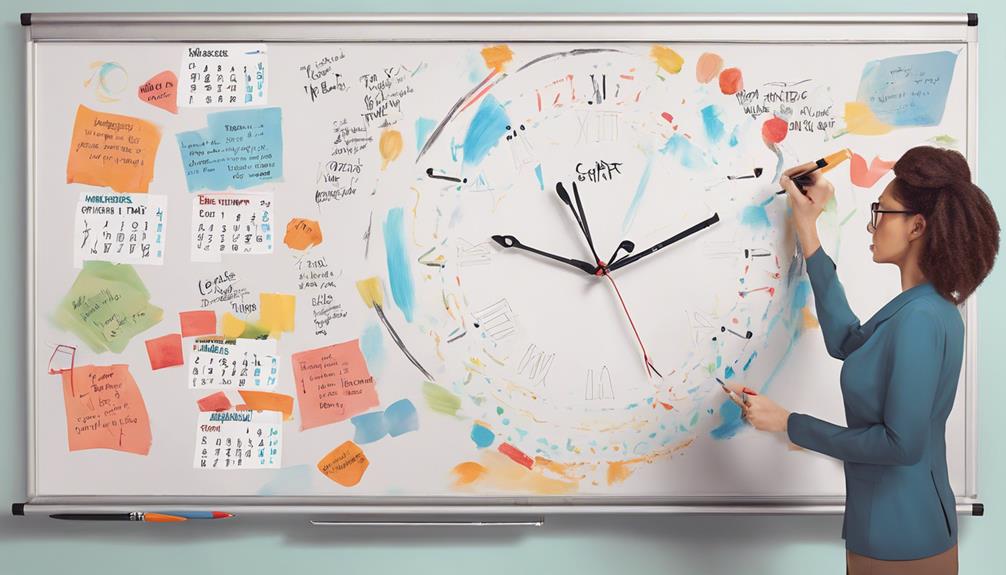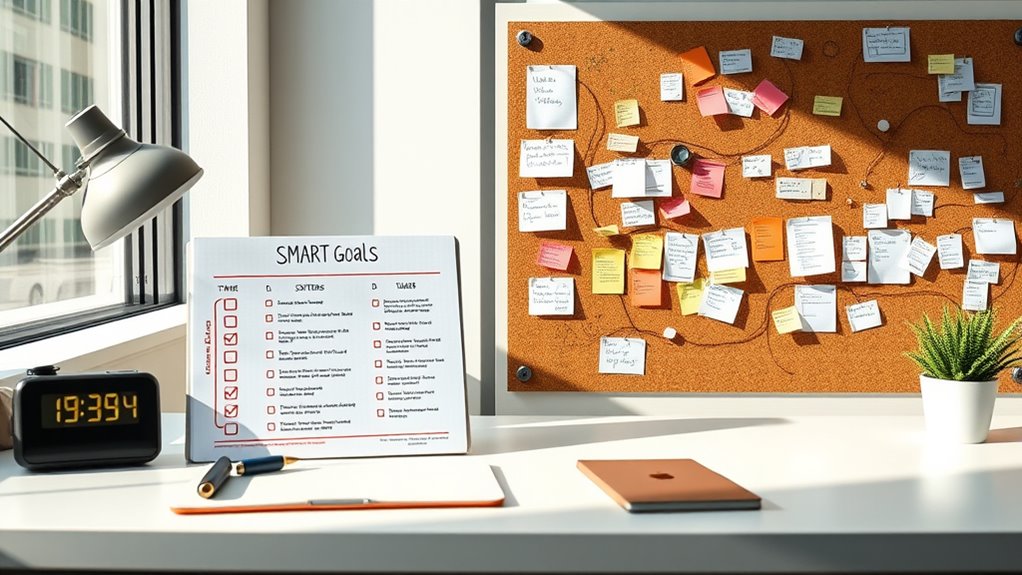To balance multiple goals without feeling swamped, begin by setting clear priorities. Allocate time wisely and focus on critical tasks first for significant strides. Break down tasks effectively using prioritization methods like the Eisenhower Matrix and tools like calendars for efficient management. Set realistic timelines with milestones to track progress consistently. Keep goals in check by conducting regular reviews and maintain adaptability. Utilize effective time management strategies and recognize signs of fatigue to prevent overwhelm. By implementing these practices, you can manage multiple goals successfully and prevent feeling swamped. Remember to stay organized and communicate clearly with any collaborators to ensure everyone is on the same page. It’s also important to maintain a healthy work-life balance to prevent burnout and maintain motivation towards achieving your dreams. With these strategies in place, you can take control of your multiple goals and work towards achieving your dreams successfully.
Key Takeaways
- Set clear priorities based on urgency and impact.
- Break down tasks effectively using prioritization methods.
- Maintain realistic timelines and adjust as needed.
- Regularly reassess goals for adaptability and focus.
- Practice effective time management strategies for balance.
Setting Clear Priorities

To avoid feeling overwhelmed, begin by clearly identifying and prioritizing the most important goals in your list. Prioritizing goals involves evaluating the urgency and impact of each goal on your overall objectives. By setting clear priorities, you can effectively allocate your time and resources, ensuring that your efforts are focused on the key objectives that will drive progress.
When prioritizing goals, it's pivotal to make strategic decisions about which goals to tackle first. This strategic approach helps prevent feeling overwhelmed by breaking down your list of goals into manageable tasks. By focusing on the most critical objectives first, you can make significant strides towards achieving your overall vision.
Setting clear priorities not only helps you stay organized but also enables you to make efficient progress towards your goals. By concentrating your efforts on the most impactful objectives, you can work towards achieving success without feeling bogged down by the sheer number of tasks at hand.
Breaking Down Tasks Effectively

When it comes to managing multiple goals, breaking down tasks effectively is key.
By utilizing task prioritization methods and time allocation strategies, you can make progress without feeling overwhelmed.
These approaches help you focus on achievable steps and maintain motivation towards your goals.
Task Prioritization Methods
Break down your tasks effectively by utilizing proven prioritization methods such as the Eisenhower Matrix, 1-3-5 Rule, ABCDE Method, MoSCoW Method, and the Pareto Principle.
- Eisenhower Matrix: Classify tasks into urgent, important, non-urgent, and non-important categories to prioritize effectively.
- 1-3-5 Rule: Focus on 1 big task, 3 medium tasks, and 5 small tasks daily to enhance productivity.
- ABCDE Method: Rank tasks as A (urgent and important), B (important but not urgent), C (delegatable), D (delegate), and E (eliminate) to streamline your priorities.
Time Allocation Strategies
Utilize strategic time allocation methods to effectively break down tasks and manage your workload seamlessly. By allocating specific time slots for each task, you can prevent overcommitting and maintain focus throughout your work.
Breaking down tasks into smaller, manageable chunks is essential to avoid feeling overwhelmed by the overall workload. Prioritizing tasks based on urgency and importance helps you stay productive and make steady progress.
Tools like calendars or apps are invaluable for scheduling tasks and tracking your progress, enabling effective time management. Implementing time management techniques such as the Pomodoro method enhances focus and productivity when tackling tasks.
Maintaining Realistic Timelines

To maintain realistic timelines effectively, make certain you break down your goals into smaller tasks with specific deadlines. This approach allows you to manage your time efficiently and track your progress more effectively. Here are three essential tips to help you uphold realistic timelines:
- Set Clear Milestones:
Break down your goals into smaller, achievable milestones with deadlines. This way, you can measure your progress and stay on track towards your larger objectives.
- Allocate Adequate Time:
Guarantee you allocate sufficient time for each task to avoid rushing and feeling overwhelmed. By setting realistic timeframes for each step, you can maintain a steady pace without unnecessary stress.
- Regularly Assess Progress:
Keep an eye on your progress and be open to adjusting timelines if needed. By regularly reassessing your goals and timelines, you can adapt to unexpected circumstances and stay on course towards achieving your objectives.
Regular Goal Reassessment

Regularly reviewing your goals is vital for maintaining focus and adaptability in achieving your desired outcomes. By examining the progress you've made, you can identify what's working well, what needs improvement, and what may need to be adjusted or even discarded.
This process of reviewing allows you to stay on track by evaluating the effectiveness of your current strategies and making necessary adjustments to guarantee continued progress.
Through regular goal review, you can pinpoint areas of success that you can build upon, areas where you may be feeling stuck or stagnant, and areas that require more attention or a different approach.
This flexibility and adaptability in managing your goals are essential for preventing overwhelm and ensuring that your goals remain relevant, achievable, and aligned with your values and aspirations.
Effective Time Management Strategies

When managing multiple goals, optimizing your time effectively is crucial to maintaining progress and preventing overwhelm.
Here are three effective time management strategies to help you stay on track:
- Identify Peak Productivity Times: Determine when you're most efficient during the day and allocate that time to work on your most challenging tasks. By leveraging your peak efficiency hours, you can tackle difficult goals more effectively and make the most of your time.
- Utilize Calendars and To-Do Lists: Set deadlines for each of your goals and track your progress using calendars and to-do lists. This visual representation can help you stay organized, prioritize tasks, and guarantee that you're making steady progress towards achieving your goals.
- Schedule Regular Breaks: Avoid burnout by incorporating regular breaks into your schedule. Taking short breaks between work sessions can help you recharge, maintain focus, and sustain overall productivity levels while managing multiple goals effectively.
Smart Task Delegation

Smartly delegating tasks to capable team members can greatly enhance efficiency in managing multiple goals. Delegating tasks allows you to leverage the strengths and expertise of your team, empowering them to take ownership of specific responsibilities. This not only lightens your workload but also fosters a sense of collaboration and trust within the team. By delegating tasks efficiently, you can guarantee that each team member is working on what they excel at, leading to better overall performance and goal achievement.
To effectively delegate tasks, consider the expertise and skills of each team member and assign tasks accordingly. Use the table below as a guide to help you match tasks with the right team member:
| Team Member | Task Assigned |
|---|---|
| John | Market Research |
| Sarah | Social Media Management |
| Alex | Project Coordination |
Smart task delegation is essential to successfully balancing multiple goals without feeling overwhelmed. Trust your team, distribute tasks wisely, and watch as your efficiency and productivity soar.
Celebrating Small Victories

To maintain momentum and boost morale while juggling multiple goals, it's important to celebrate small victories along the way. Acknowledging these small wins can have a substantial impact on your motivation and mindset.
Here are three ways celebrating small victories can benefit you:
- Boost Motivation: By recognizing and celebrating even the smallest achievements, you can keep your motivation levels high. Each small victory serves as a reminder of your progress and keeps you energized to continue pursuing your goals.
- Maintain Positive Momentum: Celebrating small victories helps maintain a positive momentum in your journey. It reinforces the idea that you're making strides towards your goals, no matter how big or small the steps may be.
- Enhance Self-Confidence: Small victories build your confidence and belief in your abilities. By celebrating these wins, you reinforce the idea that you're capable of overcoming challenges and succeeding in your endeavors.
Finding Balance Between Ambition and Self-Care

Maintaining a healthy equilibrium between ambition and self-care is important for long-term success and well-being. It's common to feel overwhelmed when working towards ambitious goals, but neglecting self-care can lead to burnout. Prioritizing self-care alongside your ambitions is crucial in preventing exhaustion and maintaining productivity.
Setting boundaries and consciously allocating time for relaxation and rejuvenation are key components of achieving this delicate balance.
Recognizing when to push forward with your goals and when to take a step back for self-care is necessary for sustainable success. It's important to listen to your body and mind, honoring the signs of fatigue and stress. Remember that self-care isn't a luxury but a necessity to fuel your ambitions in the long run.
Frequently Asked Questions
How to Balance Multiple Goals at Once?
Balance multiple goals at once by prioritizing based on excitement and constraints. Use tools like the PowerSheets Yearly Overview to plan effectively. Stack goals to streamline actions. Start small, adjust regularly, and avoid overwhelm.
How Do You Set Goals Without Being Overwhelmed?
Start by clarifying your priorities and desires. Focus on a few key aspects of your life. Set goals that align with your values and motivations. Avoid 'shoulds' and external pressures. Keep it manageable and meaningful.
Why Do I Feel Overwhelmed by My Goals?
When you feel overwhelmed by your goals, it might be due to setting too many goals without aligning them with your values. Prioritize and break down goals into manageable steps to regain focus and reduce stress.
How to Deal With Having Too Many Goals?
When you have too many goals, focus on 1-2 at a time. Use tools like PowerSheets for planning and stack goals to streamline actions. Allocate energy like a debt snowball, concentrating on a few goals each season.
Conclusion
So remember, just like juggling multiple goals, finding balance is a delicate art. Think of it like walking a tightrope – one misstep could throw you off course, but with focus and determination, you can stay on track.
Keep your priorities clear, break tasks down, and don't forget to celebrate your victories along the way.
With the right mindset and strategies in place, you can conquer all your goals without feeling overwhelmed. You got this!








